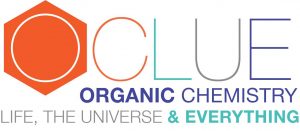 Organic chemistry is chemistry of carbon and
Organic chemistry is chemistry of carbon and
carbon-containing compounds. Since the core
structural, catalytic, information storage and retrieval
systems of organisms are carbon-based
macromolecules, organic chemistry is of direct relevance to the life sciences. Just as importantly, the properties of carbon make possible an amazing range of molecules with unique properties, from small molecules to complex plastics and even more complex biomolecules. An understanding of organic chemistry enables us to understand the properties of these substances, how they come to be synthesized and how they breakdown. Given its importance, the question then is: can we improve the design the course to make as effective and engaging as possible?
The essence of organic chemistry is how carbon atoms interact with other atoms and groups of atoms to produce an astounding array of complex and interesting molecules. The basics of bonding and intermolecular interactions are introduced in the general chemistry version of CLUE (Chemistry, Life, the Universe & Everything), along with how the structure of a molecule affects its properties, how the energy changes associated with chemical and physical changes can be predicted and explained, and how chemical systems can be stabilized or perturbed by changing conditions. These four core ideas (structure-property relationships, bonding and interactions, energy, and stability and change) are continued on into OCLUE and are deepened and expanded as we discover and explain ever more complex chemical systems. Our goal is to help you to make plausible (and correct) predictions as to what types of reactions are likely and which are unlikely to occur, and to be able to predict products for unfamiliar reactions by understanding how molecules interact. To confirm these predictions we will need to employ methods to characterize molecular structures based largely on how molecules interact with light (the field generally known as spectroscopy). Once you have a resource of reaction types and reaction systems at your disposal, we can begin to design syntheses of molecules for particular purposes, and understand how and why some biosynthetic pathways occur.
A few reminders:
Each atom is composed of a positively charged nucleus and negatively charged electrons, arranged in accord with the predictions of quantum mechanics. The properties of atoms and molecules are dependent on the way that the electrons are organized in the molecule, but in general we only need consider the behavior of the valence electrons: the electrons that are not part of the core. The core electrons are tightly attracted to the positively charged nucleus and are very difficult to dislodge, whereas the valence electrons are further away (on average) from the nucleus and therefore are more easily dislodged or moved (require less energy), because the strength of the attraction between the nucleus and the valance electrons is weaker. The strength of these nuclear/electron interactions is different for each type of atom—a fact captured in the idea of electronegativity. The stronger the nuclear attraction for the valence electrons, the more electronegative an atom is. As atoms bond together to form molecules, the electron density arrangement within a molecule (whether two or two hundred thousand or more atoms) is determined by the three-dimensional arrangement of the atoms, and the relative electronegativities of the bonded atoms. Therefore, it is possible to predict whether molecules are polar (even though they are neutral), and from the direction of the polarities we can predict how molecules will interact—that is how strong the intermolecular forces are between molecules, and also which ends of a polar molecule will interact—and then perhaps react to form a new substance.
While a bond is inherently stable, how stable it is depends on its environment. It takes energy to break any bond. You might think that all bonds are stable, but no, the kinetic energy of surrounding molecules (a function of temperature) can (through collisions) supply enough energy to break a bond. Under these conditions molecules will rearrange (through bond breaking and formation) to produce new molecules. Organic chemistry’s goal is to understand (predict) this end state, given a particular starting molecule or molecules, a particular solvent (environment), and various environmental variables (e.g. temperature) based on the behaviors of atoms and their constituents).

